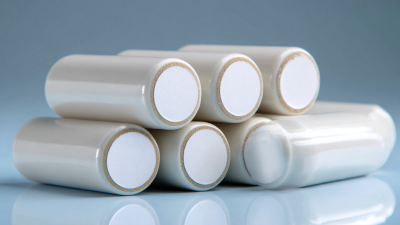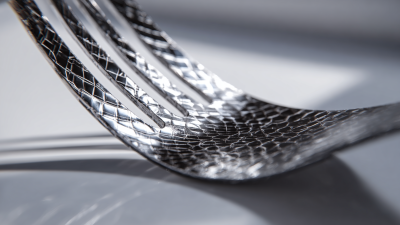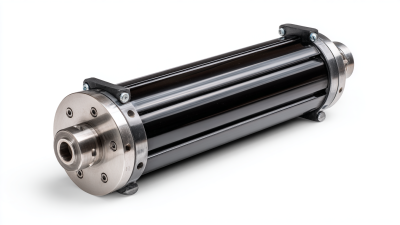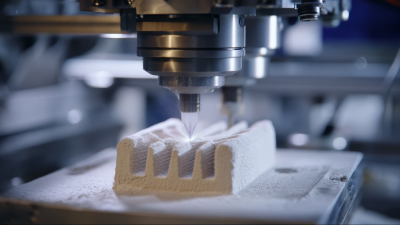Zirconia Ceramic Arm Innovations Shaping Industry Trends at the 138th Canton Fair 2025
Table of Contents
- Innovative Applications of Zirconia Ceramics in Dental Industry at the 138th Canton Fair 2025
- Market Growth Trends of Zirconia Ceramic Products Forecasted for 2025
- Comparative Analysis of Zirconia vs. Traditional Materials in Manufacturing
- Impact of 3D Printing Technology on Zirconia Ceramics Production
- Sustainability Practices in Zirconia Ceramic Production Shaping Industry Standards
- Customer Preferences and Trends in Zirconia Ceramic Arm Designs at Trade Shows
- FAQS
- Conclusion
- Related Posts
 The 138th Canton Fair in 2025 is set to showcase groundbreaking innovations in precision ceramics, particularly highlighting the advancements in Zirconia Ceramic Arm technology. As outlined in recent industry reports, the global market for advanced ceramic materials is projected to reach $33 billion by 2026, with Zirconia ceramics leading the charge due to their superior mechanical properties and biocompatibility.
St.Cera Co., Ltd., a leader in precision ceramic manufacturing, stands at the forefront of this trend, leveraging its team of top-ranking experts to push the boundaries of Zirconia Ceramic Arm applications. With an unwavering focus on research and development, St.Cera is impeccably positioned to meet the growing demand for high-performance ceramic solutions across various industries, thereby influencing the market landscape profoundly at this significant trade event.
The 138th Canton Fair in 2025 is set to showcase groundbreaking innovations in precision ceramics, particularly highlighting the advancements in Zirconia Ceramic Arm technology. As outlined in recent industry reports, the global market for advanced ceramic materials is projected to reach $33 billion by 2026, with Zirconia ceramics leading the charge due to their superior mechanical properties and biocompatibility.
St.Cera Co., Ltd., a leader in precision ceramic manufacturing, stands at the forefront of this trend, leveraging its team of top-ranking experts to push the boundaries of Zirconia Ceramic Arm applications. With an unwavering focus on research and development, St.Cera is impeccably positioned to meet the growing demand for high-performance ceramic solutions across various industries, thereby influencing the market landscape profoundly at this significant trade event.
Innovative Applications of Zirconia Ceramics in Dental Industry at the 138th Canton Fair 2025
The 138th Canton Fair 2025 showcased remarkable advancements in zirconia ceramics, particularly highlighting their innovative applications in the dental industry. Known for their exceptional strength and biocompatibility, zirconia ceramics have revolutionized dental practices, providing solutions ranging from crowns and bridges to implants. The fair demonstrated how these materials enhance the aesthetic appeal of dental restorations while ensuring durability and longevity, meeting the high expectations of both practitioners and patients.
Exhibitors presented cutting-edge techniques for manufacturing zirconia products, including the use of CAD/CAM technology, which allows for precise and customized dental solutions. Moreover, advancements in 3D printing have enabled faster production times and reduced costs, making zirconia ceramics more accessible. Discussions during the fair emphasized the importance of ongoing research and development in optimizing the properties of zirconia for better clinical outcomes, ensuring that dental professionals are equipped with the latest tools to deliver superior care.
Market Growth Trends of Zirconia Ceramic Products Forecasted for 2025
The market for zirconia ceramic products is poised for significant growth in 2025, driven by advancements in manufacturing technologies and increased applications across various industries. According to a recent report by Grand View Research, the global zirconia ceramics market was valued at approximately $1.5 billion in 2020, with projections indicating a compound annual growth rate (CAGR) of around 7.3% from 2021 to 2028. This growth is attributed to the material's superior properties such as high strength, chemical resistance, and biocompatibility, making it ideal for use in dental applications, electronics, and even aerospace components.
As we approach the 138th Canton Fair in 2025, innovations in zirconia ceramics will be a focal point, showcasing new designs and formulations that enhance performance and sustainability. A report by Market Research Future highlights that the dental sector is one of the fastest-growing segments within this market, with zirconia crowns gaining popularity due to their aesthetic appeal and durability. Additionally, the increasing demand for high-performance materials in the automotive industry further contributes to the anticipated market expansion. With these trends, the zirconia ceramic industry is not only adapting to current demands but also setting the stage for a robust future.
Comparative Analysis of Zirconia vs. Traditional Materials in Manufacturing
The 138th Canton Fair 2025 is set to feature groundbreaking innovations in zirconia ceramic arm technology, highlighting its advantages over traditional materials in manufacturing processes. Zirconia, known for its superior strength and durability, offers significant benefits such as resistance to wear and exceptional aesthetic qualities. In contrast, traditional materials often fall short in these areas, leading to increased maintenance costs and frequent replacements. The comparative analysis underscores how zirconia can enhance product longevity and performance while meeting the ever-increasing demands of modern manufacturing.
Investing in zirconia materials not only improves product quality but also streamlines production efficiency. By minimizing the need for frequent part replacements and repairs, manufacturers can reduce operational costs. Additionally, zirconia's lightweight properties facilitate easier handling during assembly lines, making it a more feasible option for high-volume production.
**Tips:** When selecting materials for manufacturing, consider conducting a cost-benefit analysis that factors in long-term sustainability. Evaluate the specific needs of your production line to determine whether zirconia's unique properties align with your manufacturing goals. A thorough understanding of material differences can lead to more informed decisions and ultimately drive your business forward.
Zirconia Ceramic Arm Innovations Shaping Industry Trends at the 138th Canton Fair 2025
| Material Type | Tensile Strength (MPa) | Density (g/cm³) | Thermal Conductivity (W/m·K) | Wear Resistance (mm³) | Cost ($/kg) |
|---|---|---|---|---|---|
| Zirconia | 900 | 6.0 | 2.5 | 2.0 | 20 |
| Alumina | 400 | 3.9 | 20 | 3.0 | 15 |
| Polymer | 300 | 1.0 | 0.2 | 50.0 | 25 |
| Titanium | 900 | 4.5 | 11 | 2.5 | 50 |
Impact of 3D Printing Technology on Zirconia Ceramics Production
The 138th Canton Fair in 2025 is showcasing innovative trends in zirconia ceramic arms, particularly emphasizing the transformative role of 3D printing technology in their production. This advancement allows for unprecedented design flexibility, enabling manufacturers to create complex geometries that were previously impractical with traditional methods. The precision of 3D printing further enhances the quality of zirconia ceramics, ensuring that products can meet the stringent demands of various industries, from dental applications to aerospace components.
Tips: When considering the integration of 3D printing in zirconia ceramics production, focus on selecting the right printer and materials. High-resolution printers can yield finer details, while specific zirconia powders can enhance the final product's mechanical properties. Experimenting with different printing parameters can lead to optimal results, maximizing strength and reducing waste during production.
Moreover, the cost-effectiveness of 3D printing provides a significant advantage for manufacturers looking to minimize operational expenses. Rapid prototyping capabilities allow companies to test designs quickly and iterate more efficiently, speeding up the overall production timeline. By embracing these technologies, businesses can not only enhance their product offerings but also position themselves competitively in the evolving market landscape for zirconia ceramics.
Zirconia Ceramic Innovations at the 138th Canton Fair 2025
This chart illustrates the production volume of Zirconia ceramics over the years, highlighting the impact of 3D printing technology on the manufacturing process. The data shows a clear upward trend in production capacity due to the advancements in 3D printing technologies.
Sustainability Practices in Zirconia Ceramic Production Shaping Industry Standards
Sustainability is becoming a cornerstone of modern manufacturing, particularly in the advanced ceramics sector, where zirconia ceramics are gaining traction. The global advanced ceramics market showcases significant growth, projected to reach substantial figures by 2033, reflecting an increasing demand for sustainable production practices. In this context, the zirconia ceramics segment stands out for its eco-friendly production methodologies and high-performance outcomes. Businesses are increasingly adopting practices that minimize environmental impact, which includes sourcing natural zircon. Reports indicate that the natural zircon segment is expected to exhibit the highest growth rates in the forthcoming years, highlighting its appeal in sustainability-driven production.

Moreover, the market for zirconia ceramic parts is anticipated to expand, fueled by innovations in manufacturing processes and a shift toward more sustainable materials. Recent market analysis indicates that the consumption of zirconia ceramics is influenced by the rising awareness of sustainability among consumers and industries alike. The integration of sustainable practices across the supply chain is reshaping industry standards, stimulating fresh opportunities for growth within the advanced ceramics market. This trend emphasizes the importance of eco-conscious approaches in ensuring both profitability and responsibility within the industry.
Customer Preferences and Trends in Zirconia Ceramic Arm Designs at Trade Shows
At the 138th Canton Fair in 2025, zirconia ceramic arms are increasingly resonating with customer preferences, prompting a shift in design trends. The rise in demand for zirconia products can be attributed to their exceptional strength, aesthetic appeal, and biocompatibility, which align well with consumer expectations in various industries, from dental to high-tech applications. Recent market analysis indicates that the global zirconia ceramics market is projected to witness a compound annual growth rate (CAGR) of approximately 7% from 2023 to 2030, driven by innovations and refinements in design and manufacturing processes.

Trade shows like the Canton Fair are instrumental in showcasing these innovations and understanding customer preferences. Notably, designs that incorporate customizability, lightweight features, and advanced functionality are gaining traction. A considerable percentage of attendees indicate that they prioritize aesthetics alongside durability when selecting zirconia ceramic products. This trend emphasizes the importance of not just robustness but also the adaptability of designs to cater to individual needs, further influencing the direction of future developments in zirconia ceramic arm technologies at trade showcases and beyond.
FAQS
: The zirconia ceramics market is projected to have a compound annual growth rate (CAGR) of around 7.3% from 2021 to 2028.
Zirconia ceramic products are known for their high strength, chemical resistance, and biocompatibility, making them suitable for applications in dental, electronics, and aerospace industries.
The dental sector is one of the fastest-growing segments due to the increasing popularity of zirconia crowns, which offer aesthetic appeal and durability.
Zirconia offers superior strength, durability, resistance to wear, and exceptional aesthetic qualities compared to traditional materials, leading to reduced maintenance costs and improved product longevity.
Investing in zirconia materials can improve product quality, streamline production efficiency, and reduce operational costs due to less frequent part replacements and repairs.
Sustainability practices in zirconia ceramic production, including eco-friendly methodologies and sourcing of natural zircon, are shaping industry standards and reflecting growing consumer and industrial demand for responsible manufacturing.
Rising awareness of sustainability among consumers and industries is influencing the consumption of zirconia ceramics, contributing to their market growth.
The 138th Canton Fair in 2025 will showcase innovations in zirconia ceramics, highlighting new designs and formulations that enhance performance and sustainability.
Manufacturers should conduct a cost-benefit analysis that includes long-term sustainability and evaluate how zirconia's properties align with their manufacturing goals.
Innovations in manufacturing processes and a shift towards more sustainable materials are expected to drive expansion in the zirconia ceramic parts market.
Conclusion
The 138th Canton Fair in 2025 highlights significant innovations in the use of Zirconia Ceramic Arm applications within the dental industry. These advancements are set against a backdrop of notable market growth trends, forecasting increased demand for Zirconia ceramic products due to their superior properties compared to traditional materials. Additionally, the incorporation of 3D printing technology is revolutionizing Zirconia ceramics production, leading to enhanced precision and customization.
Moreover, sustainability practices in the production of Zirconia ceramics are becoming vital in shaping industry standards, reflecting a growing consumer preference for eco-friendly options. As trade shows showcase the latest designs, customer preferences are steering the evolution of Zirconia Ceramic Arm designs, making them a focal point of innovation and market interest. With St.Cera Co., Ltd.'s expertise in precision ceramic manufacturing, the company is well-positioned to lead in this dynamic landscape.
Related Posts
-

Unmatched Quality: Discover the Excellence of China's Premier Zirconia Ceramic Pin Manufacturer
-

2025 Trends in Advanced Ceramics: Innovative Solutions for Best Sic Ceramic Fork Applications
-

Ultimate Checklist for Sourcing the Best Beo Ceramic Tube for Your Business Needs
-

Addressing Challenges in High-Precision Manufacturing with Bernoulli Ceramic Finger Technology
-

How to Choose the Best Sapphire Tube: Essential Metrics and Industry Insights for Global Buyers
-

5 Reasons Why the Best 4 Inch Ceramic End Effector is a Game Changer
Blog Tags:

